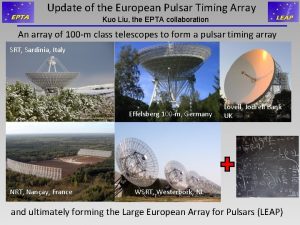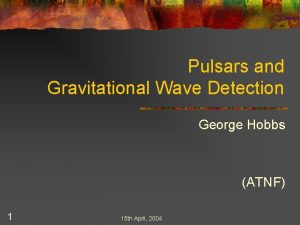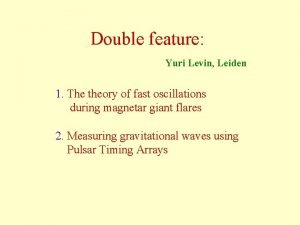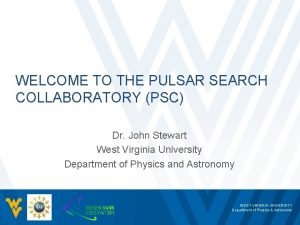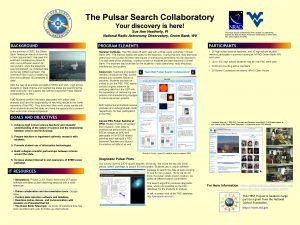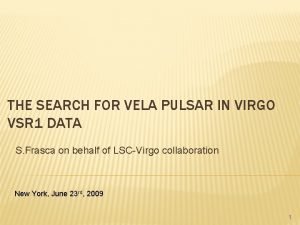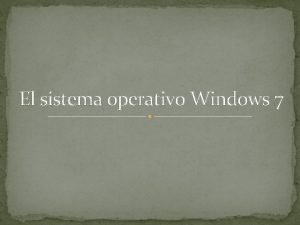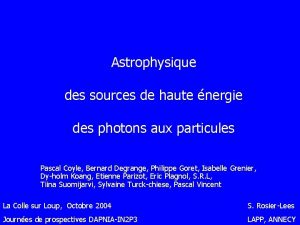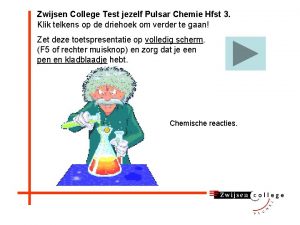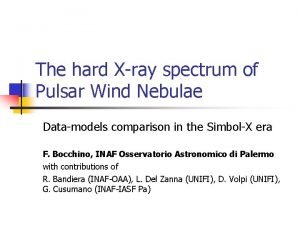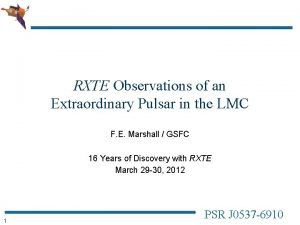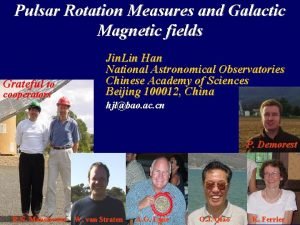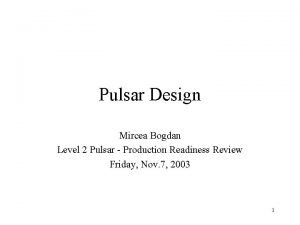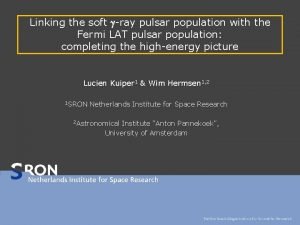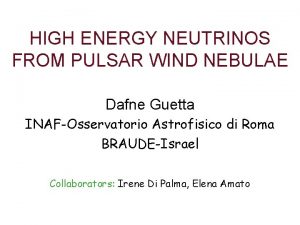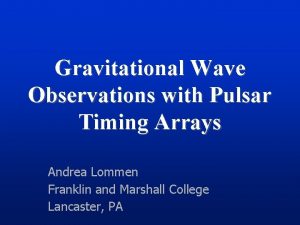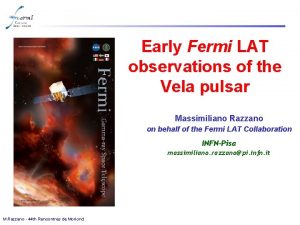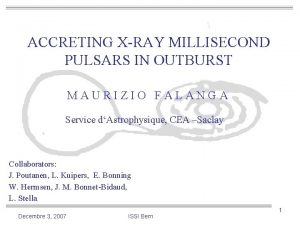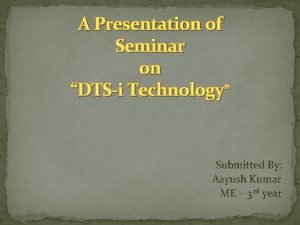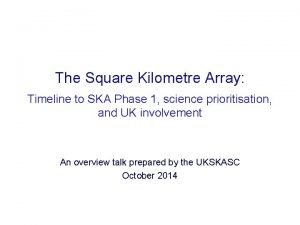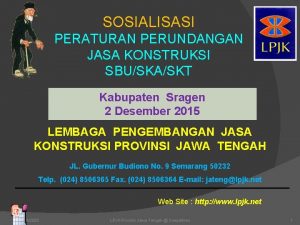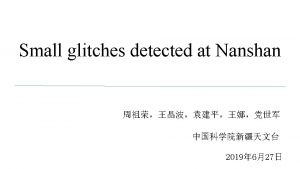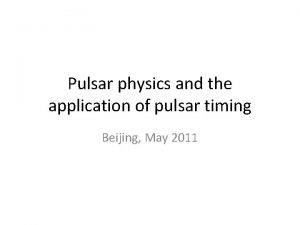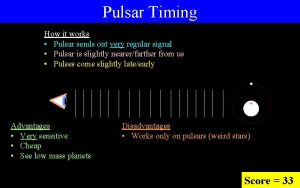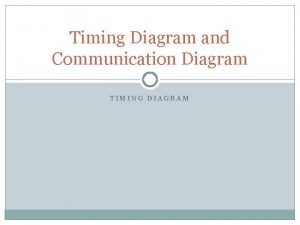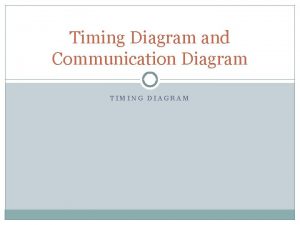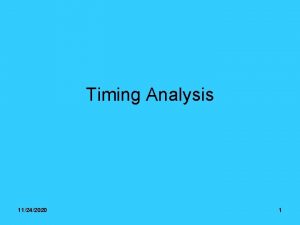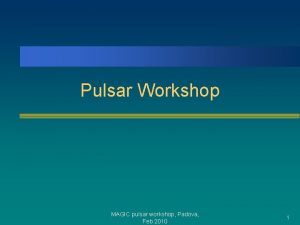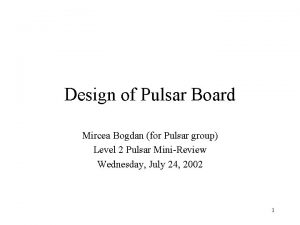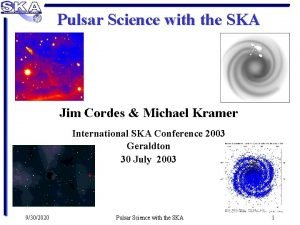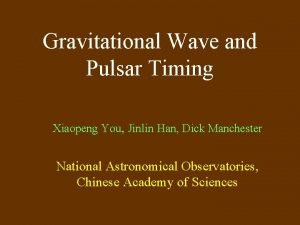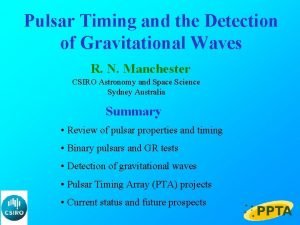The SKA as a Pulsar Search Timing and
























- Slides: 24

The SKA as a Pulsar Search, Timing and Parallax Machine Jim Cordes, Cornell University • Massive Pulsar Surveys: finding the best for gravity science • • • Complete Galactic census Galactic center (Sgr A* star cluster) Nearby galaxies with periodicity surveys Giant pulses to Virgo Expected yields SKA requirements • Timing precision issues • Pulsars as clocks • TOA estimation, optimization • SKA (VLBI) astrometry: parallaxes to >10 kpc • Areas of commonality with LISA & GAIA 11/26/2020 Jim Cordes Joint LISA/SKA/GAIA Meeting 20 50

The SKA as a Pulsar/Gravity Machine • Relativistic binaries (NS-NS, NS-BH) for probing strongfield gravity • Orbit evolution of pulsars around Sgr A* • Millisecond pulsars < 1. 5 ms (EOS) • MSPs suitable for gravitational wave detection • 100 s of NS masses (vs. evolutionary path, EOS, etc) • Galactic tomography of electron density and magnetic field; definition of Milky Way’s spiral structure • Target classes for multiwavelength and non-EM studies (future gamma-ray missions, gravitational wave detectors) Millisecond Pulsars Today Future SKA Relativistic Binaries Today Future SKA Blue points: SKA simulation Black points: known pulsars only 6! 11/26/2020 Jim Cordes Joint LISA/SKA/GAIA Meeting ~104 pulsar detections

• P ~ 5 -12 s • B ~ 1014 – 1015 G • Canonical pulsars • P~ 20 ms – 5 s • B ~ 1012± 1 G • Recycled/Millisecond pulsars (MSPs) • P ~ 1. 5 – 20 ms • B ~ 108 – 109 ms • Braking index n: log Period derivative (s s-1) • Magnetars+high-field pulsars • Pdot P 2 -n, n=3 magnetic dipole radiation • Death line • Strong selection effects 11/26/2020 Jim Cordes Joint LISA/SKA/GAIA Meeting Period (sec)

Pulsar Search Domains Region/Direction Galactic Plane Galactic Center Moderate Galactic latitudes Kind of Pulsar Young pulsars (< 1 Myr) Telescopes Arecibo, Effelsberg, GBT, Jodrell, Parkes, WSRT, SKA Young, recycled, GBT, SKA binary, circum-Sgr. A* MSPs, binary, Arecibo, GBT, runaway Parkes, SKA Globular clusters MSPs, binary Arecibo, GBT, Parkes, SKA Local Group Galaxies Young (probably) Giant pulses Arecibo, GBT, SKA 11/26/2020 Jim Cordes Joint LISA/SKA/GAIA Meeting

Dmax vs P Dmax = maximum detectable distance for period P given luminosity Lp Detection curves take into account interstellar scattering (NE 2001 model) instrumental effects, additive noise 11/26/2020 Jim Cordes Joint LISA/SKA/GAIA Meeting

Galactic Center Region Sgr A* = 3 106 black hole with a surrounding star cluster with ~ 108 stars. Many of these are neutron stars. Detecting pulsars in Sgr A* is difficult because of the intense scattering screen in front of Sgr A*. Multipath differential arrival times d ~ 2000 ν-4 sec 327 MHz VLA image 11/26/2020 Jim Cordes Joint LISA/SKA/GAIA Meeting Solution: high frequency and large collecting area (SKA)

11/26/2020 Jim Cordes Joint LISA/SKA/GAIA Meeting

The brightest pulses in the Universe Cordes et al 2004 Giant pulse from the Crab pulsar S ~ 160 x Crab Nebula ~ 200 k. Jy Detectable to ~ 1. 5 Mpc with Arecibo 6 Mpc with SKA (full) Reach Virgo on strongest pulses? Hankins et al 2003: 2 ns substructure in GPs 11/26/2020 Jim Cordes Joint LISA/SKA/GAIA Meeting

Birth Rates and Population Numbers The SKA has high detection probabilities for most of these objects “full Galactic census” of these NS sub- populations 11/26/2020 Jim Cordes Joint LISA/SKA/GAIA Meeting

Pulsar Timing Precision: Pushing the Limits • Pulsars as clocks • Spin stability: departure from smooth spindown • Phase jitter of pulsar beam w. r. t. spin phase • Intrinsic and extrinsic torques • Pulsar motion and acceleration • Perturbations of the pulses • plasma perturbations (ISM, IPM, ionosphere) • telescope effects: – Additive noise – Instrumental polarization • Time tagging • Matched filter estimation of time of arrival • Barycentric correction • Observatory time and time transfer • What can we do differently and better? • Pre-SKA with Arecibo, EVLA, Parkes, Jodrell, etc. • SKA 11/26/2020 Jim Cordes Joint LISA/SKA/GAIA Meeting

Differential rotation, superfluid vortices Interstellar dispersion and scattering Glitches Spin noise Emission region: beaming and motion 11/26/2020 Uncertainties in planetary ephemerides and propagation in interplanetary medium GPS time transfer Additive noise Instrumental polarization Jim Cordes Joint LISA/SKA/GAIA Meeting

log Period derivative (s s-1) Best timing: • Short periods • Small fields • Slow spindown 11/26/2020 Worst timing: • Long periods • Large fields • Fast spindown Issues: • Differential rotation between crust and superfluid • Torque variations • Accretion events? Period (sec) Jim Cordes Joint LISA/SKA/GAIA Meeting • injected asteroids

How Good are Pulsars as Clocks? 11/26/2020 Jim Cordes Joint LISA/SKA/GAIA Meeting

Phase residuals from isolated pulsars after subtracting a quadratic polynomial: If these pulsars were simply spinning down in a smooth way, we would expect residuals that look like white noise: For these pulsars, the residuals are mostly caused by spin noise in the pulsar 11/26/2020 Jim Cordes Joint LISA/SKA/GAIA Meeting

MSP J 1909 -3744 P=3 ms + WD Jacoby et al. (2005) Weighted TOA = 74 ns Shapiro delay 11/26/2020 Jim Cordes Joint LISA/SKA/GAIA Meeting

, + ISS effects (Foster & Cordes 1990) 11/26/2020 Jim Cordes Joint LISA/SKA/GAIA Meeting

TOA Optimization vs. frequency (modeled): MSP+ SKA Small DM For this case, TOAs are best at ν > 1 GHz but are dominated by pulse phase jitter TOA T-1/2 so longer integration times can push the error down to 10 ns 11/26/2020 Jim Cordes Joint LISA/SKA/GAIA Meeting

TOA Optimization vs. frequency (modeled): MSP+ SKA Large DM For this case, TOAs are best at ν > 2 GHz because of scattering but are dominated by pulse phase jitter TOA T-1/2 so longer integration times can push the error down to 10 ns 11/26/2020 Jim Cordes Joint LISA/SKA/GAIA Meeting

Mitigation of TOA Estimation Errors • Polarization purity • need -40 d. B accuracy after hardware and post processing across the entire FOV used for timing • Pulse amplitude/phase jitter • limitations on optimality of matched filtering • Error-correction algorithms: use correlations of pulse shape perturbation with TOA perturbation (unpublished) • Electron density fluctuations in the ISM • 103 km to > pc (~Kolmogorov) • DM(t) … correctable • Time-variable pulse-broadening function … partly correctable – Secular (months, years): refractive modulation – N effects from finite number of scintles in the f-t plane • Time-variable angle of arrival – Refraction from large-scale structures in the ISM • Use high frequencies 11/26/2020 Jim Cordes Joint LISA/SKA/GAIA Meeting

Pulse Timing Efficiency with the SKA • Follow up timing required to varying degrees on the >104 pulsars discoverable with SKA • Spin parameters, DM and initial astrometry • Orbital evolution for relativistic binaries • Gravitational wave detection using MSPs • Each deg 2 will contain only a few pulsars efficient timing requires large solid-angle coverage (lower frequencies, subarrays, wide intrinsic FOV, or multiple FOVs) 11/26/2020 Jim Cordes Joint LISA/SKA/GAIA Meeting

Pulsar Astrometry with the SKA (interferometry on long baselines) • Pulse timing models and reference frame definition • Proper motions and parallaxes for objects across the Galaxy monitoring programs over ~ 2 yr/pulsar • Optimize steep pulsar spectra against -dependence of ionospheric and tropospheric and interstellar phase perturbations ( 2 to 8 GHz) • Current state of the art: 4 kpc using VLBA ~ 1% SKA • In-beam calibrators (available for all fields with SKA) • 10% of A/T on transcontinental baselines implies 20 times greater sensitivity over existing dedicated VLB arrays 11/26/2020 Jim Cordes Joint LISA/SKA/GAIA Meeting

B 1508+55 Chatterjee et al. 2005 l, b = 91. 3 o, 52. 3 o D = 2. 45 0. 25 kpc V = 1114 -94 +132 km s-1 P = 0. 74 s B = 2 x 1012 G = P/2 Pdot = 2. 36 Myr The highest measured velocity using direct distance measurement 2. 5 x further than electron density model based distance estimate (NE 2001) 11/26/2020 Jim Cordes Joint LISA/SKA/GAIA Meeting Possibly born in Cyg OB 7

SKA Specifications Summary for Fundamental Physics from Pulsars Required Specification Topic Searching t ( s) 50 A/T (m 2/K) 2 x 104 fc max (GHz) Configuration FOV Sampling Polarization 2. 5 15 (GC) Core with large fc full Total Intensity 100 Timing � 1 2 x 104 15 Non-critical if phasable Astrometry (VLB) 200 >2 x 103 8 Intercontinental baselines 11/26/2020 Jim Cordes Joint LISA/SKA/GAIA Meeting beams/deg 2 ~ 3 beams Full Stokes; -40 d. B isolation Total Intensity

Summary & Discussion • SKA will discovery many binaries and MSPs suitable for • Testing gravity in the strong field limit • n. Hz gravitational wave detection • Objects can be “cherry picked” to be the best clocks • Methods exist or are under development for correcting TOAs for intrinsic self noise (jitter) and instrumental polarization • Commonality between LISA, GAIA and SKA/pulsar communities: • Overall goals (gravitational waves as target and tool) • Astrophysical populations • Methodologies (matched filtering, sparse signal detection amid noise) • Promotion of gravity science in a competitive funding world 11/26/2020 Jim Cordes Joint LISA/SKA/GAIA Meeting
 Pulsar timing
Pulsar timing Pulsar
Pulsar Yuri levin
Yuri levin Pulsar search collaboratory
Pulsar search collaboratory Pulsar search collaboratory
Pulsar search collaboratory Vela pulsar
Vela pulsar Al pulsar el botón derecho del ratón, generalmente
Al pulsar el botón derecho del ratón, generalmente Neutralino
Neutralino Vraag 3
Vraag 3 Pulsar wind
Pulsar wind Pulsar
Pulsar Pulsar wind
Pulsar wind Pulsar
Pulsar Pulsar analytics
Pulsar analytics Pulsar
Pulsar Pulsar
Pulsar Pulsar wind
Pulsar wind Pulsar
Pulsar Pulsar
Pulsar Pulsar
Pulsar Bajaj pulsar 180 dtsi digital twin spark ignition
Bajaj pulsar 180 dtsi digital twin spark ignition Ska phase
Ska phase Konversi sbu ke kbli 2020
Konversi sbu ke kbli 2020 Ska skills knowledge attitude
Ska skills knowledge attitude Ska rating
Ska rating
